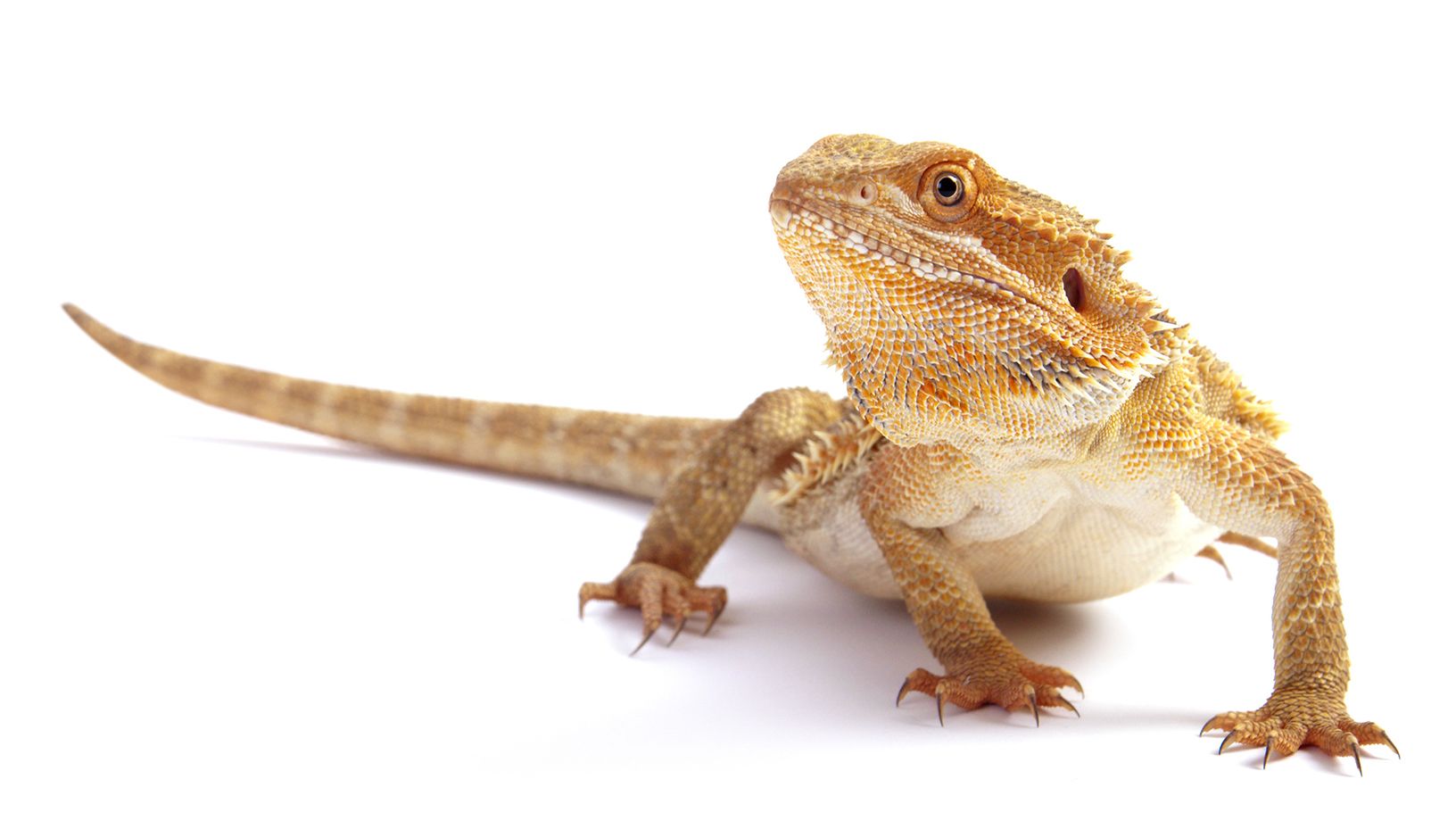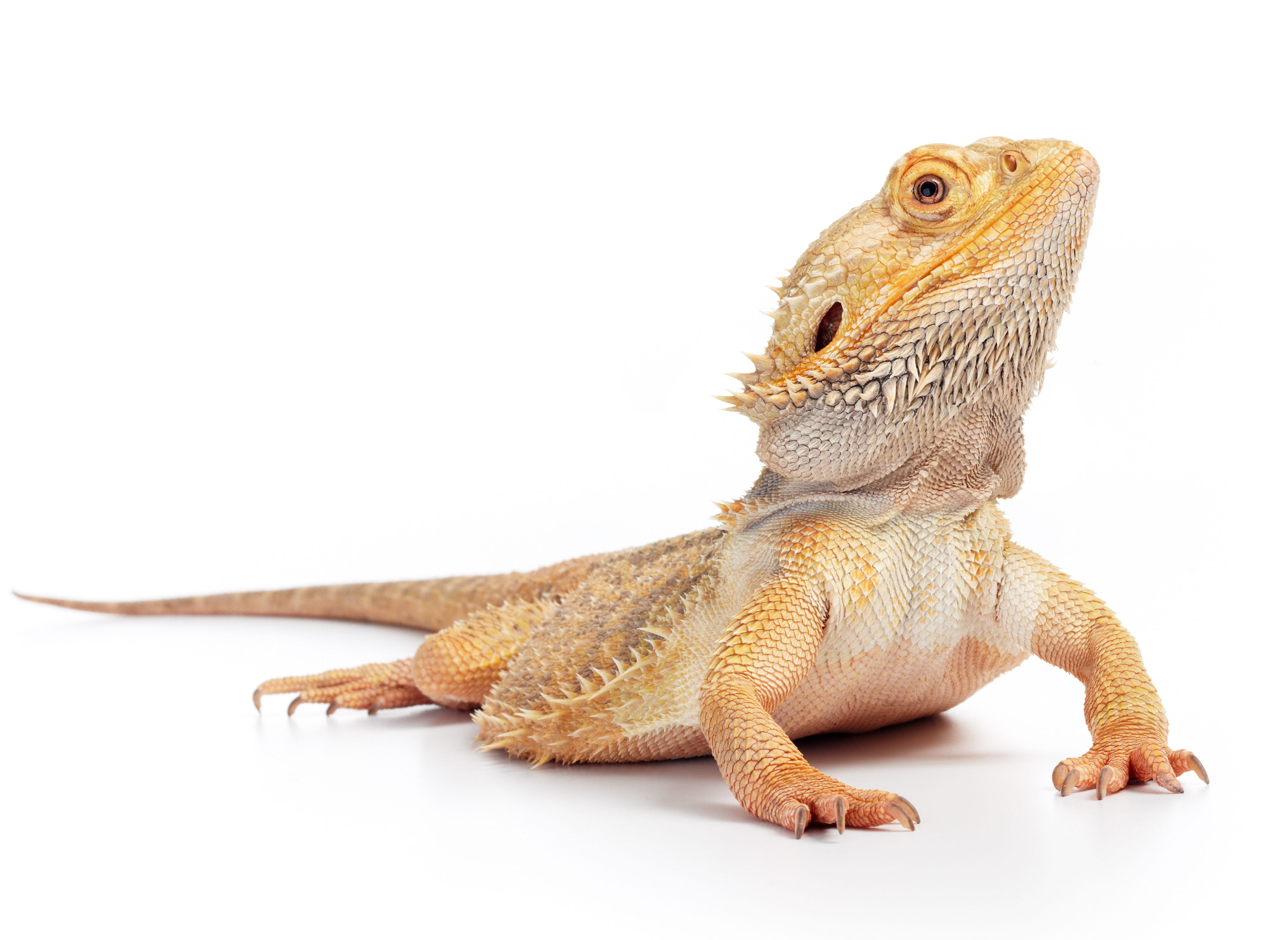Bearded Dragon Care Guide

In this Article
Brash and Bold Bearded Dragons!
Bearded dragons, also called “beardies,” are lizards native to Australia that are very popular pets today. They get their name for the spiny “beard” on their chin, which they use for communication. Bearded dragons are great additions to the family, whether someone is new to exotic pet ownership or are well versed in exotic ownership. Bearded dragons are typically very tolerant of handling, so if you’re looking for a lizard who’d be happy to hang out on your shoulder, a beardie might be right for you!
Bearded dragon species profile
Size: Bearded dragons can grow up to 24" (61 cm).
Lifespan: Bearded dragons live approximately 10+ years.
Behavior: Diurnal, meaning active during the daytime. Beardie are social with people, but should be housed alone as adults
Did you know?
Bearded dragons wave their arms and bob their heads to communicate and establish dominance. Their beard is also used to communicate, and it will turn black when stressed, agitated, ill, or excited. These visual cues help pet parents monitor their dragon’s mood and well-being.
Bearded dragons wave their arms and bob their heads to communicate and establish dominance. Their beard is also used to communicate, and it will turn black when stressed, agitated, ill, or excited. These visual cues help pet parents monitor their dragon’s mood and well-being.
Setting up your bearded dragon habitat

Bearded dragons need a warm, dry environment with space to explore, and bask. A well-set-up enclosure helps prevent stress, illness, and behavioral issues.
Enclosure size and flooring
- Juveniles need at least a 20-gallon terrarium
- Adults require more space. Use this formula from the Association of Reptile and Amphibian Veterinarians:
- Measure your dragon from nose to tail tip
- Multiply that number by 4 to calculate the minimum square inches of floor space
- Example: A 24-inch dragon needs at least 96 square inches (about 8 square feet), so a 4 ft x 2 ft terrarium is ideal
- Use reptile carpet, textured mat, or ceramic tile for the floor of your enclosure
- For beardies under 6 months, paper towels are best for easy cleaning
- Avoid loose substrates like sand (including calcium sand), walnut shells, corn cob, kitty litter, alfalfa pellets, or wood shavings. These can cause impaction if ingested and are a serious medical risk
- Place your lighting outside the enclosure, over the screened lid, with the heat light focused more on one side to create a basking area.
- Include driftwood or rocks to allow your bearded dragon to climb closer to the heat source—just be sure they can’t get so close that they risk burns. Add a few sturdy branches to provide both hiding spots and climbing enrichment.
- Provide a shallow dish for food and a shallow water dish. In addition to water available for drinking, your beardie will also benefit from weekly warm-water soaks in water deep enough to reach their chest, but not so deep they cannot stand and walk in it. This can aid in hydration, gastric motility (help keep things moving), and can help with the shedding process if there is stuck shed. Do not leave your bearded dragon unattended during soaks.
Clean droppings regularly. Deep-clean the entire enclosure at least every two weeks.
Temperature, humidity, and lighting
Bearded dragons require a temperature gradient in their habitat (a cool side and a warm side). Add 2 thermometers, one on the cool side and one on the basking area, and a hygrometer to monitor temperature and humidity.
Mist your bearded dragon’s enclosure daily with a warm water spritz to maintain humidity.
Zone | Temperature |
Cool side | 75–85°F (24–29°C) |
Warm side | 85–90°F (29–35°C) |
Basking spot | 95–100°F (35–38°C) |
Nighttime | 68–74°F (20–23°C) |
Humidity | 30–50% |
Bearded dragons require a 12-hour day/night cycle. Putting your lighting on an automatic timer will make this easier for you. As long as your enclosure does not go under 68F overnight, you do not need to provide heat overnight.
- Many reptiles and amphibians benefit from having access to UVB lighting. UVB allows the body to synthesize vitamin D3 which is critical for absorption of calcium. Some daylight bulbs will be rated to also provide UVB, and some won’t so it is important to check. Providing low-intensity UVB light over the warm-side of your pet’s habitat is recommended.
For more information, consult PetSmart's "Reptile & Amphibian Heating & Lighting" and "Setting Up a Reptile or Amphibian Habitat" Care Guides.
Feeding your bearded dragon

Feeding
Bearded dragons are omnivores when young, eating a mix of insects and plant matter. While young, they tend to eat more protein than they do vegetation. As they mature, their diet shifts toward mostly vegetables with occasional protein.
Diet breakdown by age
- Juvenile bearded dragons (under 12 months):
- ~50% insects, ~50% plant matter
- Feed live prey once daily
- Offer fresh vegetables every day
- Adult bearded dragons (12 months and older):
- ~90% plant matter, ~10% insects
- Feed insects 2 to 3 times per week
- Offer vegetables daily
Insects
- Primary prey: gut-loaded crickets or dubia roaches
- Occasional treats: mealworms, superworms, and waxworms (in small amounts only)
- Always dust insects with supplements:
- Calcium with vitamin D3:
- 4–5 times/week (juveniles)
- 2–3 times/week (adults)
- Multivitamin:
- Once/week (juveniles)
- Twice/month (adults)
What does “gut-loaded” mean?
Gut-loaded insects have been fed a high-nutrient diet before being offered to your pet. This boosts the nutritional value of the feeder insects and supports your bearded dragon’s health.
Gut-loaded insects have been fed a high-nutrient diet before being offered to your pet. This boosts the nutritional value of the feeder insects and supports your bearded dragon’s health.
Vegetables and fruits
- Daily veggies:
- Dark leafy greens (like collards, dandelion greens)
- Carrots, squash, yams, sugar snap peas
- Weekly fruit treat:
- Melons, mango, berries, banana
- Feed fruit once a week at most, in small amounts
Prepared diets
- You can offer pelleted bearded dragon food daily, moistened with water
- Use as a supplement to live insects and vegetables, not a sole diet
Hydration
- Keep a shallow water dish in the habitat at all times
- Offer weekly warm-water soaks in a container deep enough to reach chest level but shallow enough for your dragon to stand and walk
- Soaks help with hydration, digestion, and shedding
- Never leave your bearded dragon unattended during a soak
Do not feed wild insects
Insects from outside may carry parasites or pesticides that can make your dragon very sick. Always use commercially raised, safe feeder insects.
When to see a vet
In addition to regularly scheduled appointments, contact your reptile veterinarian if you notice the following signs:
- runny droppings for more than two days
- decreased frequency in droppings
- eating or drinking less; weight loss
- swollen joints or reluctance to move
- discharge from the eyes, nose or mouth
- shedding problems; discolored skin
- avoidance of the basking area; more time spent hiding
- increased basking time
- “stargazing” -a posture where the dragon arches its neck and looks upwards at the sky
- Missing or “dropped” tail- unlike some geckos, bearded dragons do NOT regrow their tails. A suddenly missing tail is serious in bearded dragons and veterinary care should be sought ASAP
Go to “find a vet” on arav.org for help finding a reptile veterinarian in your area. NOTE: Most, if not all, reptiles carry Salmonella bacteria in their intestinal tract and intermittently or continuously shed these bacteria in their feces, so they are unsuitable pets for very young children and those with compromised immune systems. Good hygiene must always be practiced around all reptiles, and hands should be washed before and after interacting with reptiles.
SHOPPING CHECKLIST
- Terrarium
- Juvenile: 20 gallon terrarium at minimum
- Adult: 40-75 gallon terrarium at minimum
- screened lid
- UVB bulb and fixture
- basking bulb and lamp
- habitat thermometer(s) and hygrometer
- food bowl
- water bowl
- artificial/natural rock or wood hiding spot
- branches/plants for climbing and hiding
- reptile-safe substrate
- hide
- bearded dragon pelleted food
- live crickets, dubia roaches and mealworms
- calcium powder
- multivitamin powder
Ready to learn more? This guide is a great starting place, but we encourage you to do more research on the individual species that you are keeping so that you can be as successful as possible!
Related guides:
FAQs
How often should I handle my bearded dragon?
Bearded dragons are generally tolerant of handling and can be interacted with daily, once they’re used to you. Keep sessions short at first and always support their body fully. Avoid handling during shedding or if your dragon seems stressed.
Bearded dragons are generally tolerant of handling and can be interacted with daily, once they’re used to you. Keep sessions short at first and always support their body fully. Avoid handling during shedding or if your dragon seems stressed.
Do bearded dragons need UVB light?
Yes. UVB exposure is essential for vitamin D3 synthesis and proper calcium absorption. Without it, bearded dragons can develop metabolic bone disease. Use a low-intensity UVB bulb and replace it every six months, even if it still lights up.
Yes. UVB exposure is essential for vitamin D3 synthesis and proper calcium absorption. Without it, bearded dragons can develop metabolic bone disease. Use a low-intensity UVB bulb and replace it every six months, even if it still lights up.
Why is my bearded dragon’s beard turning black?
A black beard can signal stress, illness, or dominance behavior. Check for signs of improper temperatures, poor diet, or illness. If it persists, consult a reptile veterinarian.
A black beard can signal stress, illness, or dominance behavior. Check for signs of improper temperatures, poor diet, or illness. If it persists, consult a reptile veterinarian.
What vegetables can bearded dragons eat daily?
Offer dark leafy greens like collard greens, mustard greens, and dandelion greens. Avoid spinach and iceberg lettuce, which have limited nutritional value or may interfere with calcium absorption.
Offer dark leafy greens like collard greens, mustard greens, and dandelion greens. Avoid spinach and iceberg lettuce, which have limited nutritional value or may interfere with calcium absorption.
How can I tell if my bearded dragon is dehydrated?
Signs include wrinkled skin, sunken eyes, and sluggish behavior. Ensure your dragon has access to fresh water, is misted regularly, and receives occasional warm water soaks to stay hydrated.
Signs include wrinkled skin, sunken eyes, and sluggish behavior. Ensure your dragon has access to fresh water, is misted regularly, and receives occasional warm water soaks to stay hydrated.

